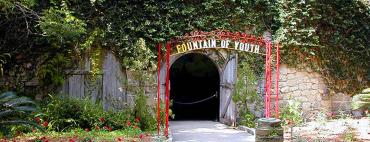
Six additional places in Florida have been added to the National Park Service’s National Register of Historic Places, Secretary of State Ken Detzner announced Tuesday.
Detzner explained the six new historical places span the entire state from South Florida to the Florida Panhandle and reflect the variety of culture found throughout the Sunshine State.
“These newly listed sites stretch from Pensacola to Miami, and represent homes, entertainment venues, and commerce and tourist sites that reflect the geographic and cultural diversity of our state,” he said.
The Marzoni House, Pensacola, Escambia County
The Marzoni House is a three-story home in the Queen Anne Style architecture which was popular in the late 19th and early 20th centuries. The house has an octagonal tower was built in 1890, and by 1900 had doubled in size to include a new two-story porch. The interior finishes and ornamental wood work feature fluted door and window trim with rosette blocks at the corners, decorative wood wall and door panels, wide chair rails and picture rails, and a beaded screen between the foyer and parlor. The home currently serves as a bed and breakfast.
The Fountain of Youth Archaeological Park, St. Augustine, St. John’s County
St. Augustine is perhaps one of Florida’s most historical cities. Walter B. Fraser developed this park in the 1930s, but its history stretches back to the 1500s when it was on the history of the 1513 landing of Don Juan Ponce de Leon and famous search for eternal youth. A well whose water is said to reflect this story has been enclosed by the Spring House, attracting many visitors and tourists who can even sample the water from the well.
The Sydonie Mansion, Zellwood, Orange County
The Sydonie Mansion is a Mediterranean Revival style three-story mansion built in the early 1900s. The constructed in 1904 as a winter home for James H. Laughlin, Jr., and his wife Sydney Ford (Page) Laughlin for whom the house was named. Laughlin’s father, James H. Laughlin, Sr., was a wealthy banker, manufacturer, philanthropist, and steel executive in Pittsburgh, Pennsylvania. The mansion was designed a well-known American architect named by Grosvenor Atterbury (1869-1956) and urban planner, and architect Edgar Vigners Seeler (1867-1929). The design of the house was said to have been inspired by the Alhambra Castle in Spain. The property included sculpted gardens with rare plants from around the world, as well as citrus groves, a dairy farm, a power plant and a bowling alley. The restored home is now open for weddings and events.
The Scott Commercial Building, Sarasota, Sarasota County
The Scott Commercial Building is a modern style building constructed in 1960 by William Rupp. The Scott Building is representative of the Sarasota School of Architecture, a regional movement of mid-century modern architecture that developed on South Florida’s gulf through the work of a group of skilled designers. A one-story rectangular building with stucco exterior, large picture windows, flat roof, and large extending concrete rafter beams, the building footprint covers 10,066 square feet. The Scott Building has been fully restored.
The West Palm Beach Fishing Club, West Palm Beach, Palm Beach County
The West Palm Beach Fishing Club helped promote tourism and fishing in Palm Beach County. Founded in 1934, the clubhouse is still in use today. The club continues to play a role in conserving aquatic populations through cooperative game fish tagging, catch & release of all billfish, deploying an artificial reef off the coast of Florida and sponsoring educational programs for adults, children and students.
The Ace Theatre, Miami, Miami-Dade County
The Ace Theatre is over 75 years old and has been associated with the social, cultural and economic development of the African-American section of Coconut Grove and Miami. Built in 1930, the theater provided entertainment for black communities throughout Miami-Dade County. It is one of the last remaining theaters built, owned and/or operated by Wometco Enterprises that has not been repurposed. Future plans include restoration of the theatre as a multi-use entertainment facility.


